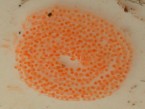_______________
Additional Photos

underside

side

smooth

elongate papillae

dark head

rust-brown

white

unrolled rhinophores

egg mass
_______________
GALLERY

|
Elysia sp. #6

Maximum size: 7 mm.
Identification:
This
is a small, highly cryptic species with two chimneys on its
parapodia, the anterior much taller than the posterior, and prominent
ridges on the front of its head. Typical animals
are mottled in cream and brown, often with a
peach tinge. Most have prominent white patches in front of the
parapodia and anterior to the tip of the foot, however one
or both of them may be absent. Occasionally, the parapodia may
be gray or a black patch may be present on top of the head. A bluish
sheen may be visible in front of the rhinophores, turquoise spots may
appear above the eyes and green patches may occur on the edges of the
taller chimney. The
rhinophores are short, usually with a translucent medial band. The body
surface
ranges from nearly smooth to strongly papillate and occasional animals
have greatly elongate papillae on the posterior margins of one or both
rhinophores.
Natural history:
Elysia sp. #6 is a
common, though seldom seen, plakobranchid found on
rocky bottoms. It
occurs in moderately protected to moderately exposed locations from
< 1 to 18
m (3-59 ft). Mature individuals are diurnally active and the
parapodia are
jerked intermittently while crawling. Animals as little as 3 mm in
length are sexually mature. The yellow to orange egg masses are
tightly
coiled spirals only 1-2 mm in diameter and the egg ribbon has a
somewhat wrinkled surface. Two or three irregular bands of
superficial pigment are usually present on the egg ribbon and range
from cream to light
orange in color. Hatching occurs in about five days in the
laboratory and the pigment bands remain in the mass after hatching.
Distribution:
Maui, Oahu and Kauai: widely distributed in the western & central Pacific.
Taxonomic notes:
It was first
recorded in Hawaii from Kapalua Bay, Maui by CP on April 22, 1996.
Photo: CP:
4.5 mm: Hekili Point, Maui; June 3, 2003.
Observations and comments:
Note
1: ( )
|
|










